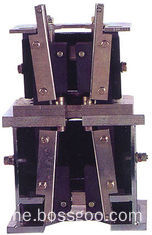First, the introduction of trench oil:
Ditch oil (squat oil), the oil extracted from the leftover food. According to calculations by relevant departments, the various types of hotels in a city produce no more than 3,000 tons of waste oil per month. The waste oil is very harmful. According to scientific tests, the rancidity and carbonyl price of the waste oil far exceed the national edible oil hygiene index. The rancid oil damages several enzyme systems such as cytochrome enzymes in the body. The high oxidation of oil produces aflatoxin toxin, which can cause a variety of cancers. The long-term intake of rancid oils and fats in animals will cause weight loss and development. obstacle. The highly toxic aflatoxin in the waste oil is 100 times more toxic than arsenic and is the strongest chemical carcinogen found so far. Experiments have shown that long-term low-dose aflatoxin can cause 100% of liver cancer in animals, and cancer can occur in other parts, such as gastric adenocarcinoma, kidney cancer, rectal cancer, and breast, ovary, small intestine and other cancers.
Aflatoxin (AFT) is a group of chemically similar compounds. Currently, 12 species have been identified, including B1, B2, G1, G2, M1, M2, P1, Q, H1, GM, B2a and toxic alcohol. The basic structure of aspergillin is difuran ring and coumarin, and B1 is a derivative of dihydrofuran oxaphthalene. It contains a difuran ring and an oxaphthalene (coumarin). The former is basic. Toxic structure, the latter is related to carcinogenesis. M1 is a metabolite derived from aflatoxin B1 by hydroxylation in the body. The main molecular formulas include B1, B2, G1, G2, M1, M2, etc. Among them, M1 and M2 mainly exist. In milk, B1 is the most toxic and carcinogenic substance. A class of chemically similar compounds are derivatives of dihydrofuran coumarin. Aflatoxin is a secondary metabolite produced primarily by Aspergillus flavus, a. parasiticus, with the highest incidence of aflatoxin in food and feed in hot and humid regions.
Second, the response plan
The limit of aflatoxin b1 is clearly defined in the previous relevant food hygiene standards, including: corn, peanut kernels, peanut oil should not exceed 20ug/kg; rice and other oils used should not exceed 10ug/kg; other food, Beans and fermented foods shall not exceed 5 ug/kg; aflatoxin b1 shall not be detected in infant milk substitute foods.
For the detection of aflatoxin b1 exceeding the standard in the trench oil, combined with the relevant detection standards, it can be detected by high performance liquid chromatography instrument with fluorescence detector to ensure the quality and safety of the edible oil for people.
LC310 High Performance Liquid Chromatography Instrument Configuration:
P310 high pressure infusion pump: 2 sets
High pressure static mixer (1.7ml): 1 set
7725i manual injection valve: 1 set
Post-column derivative: 1 set
Fluorescence detector: 1 set
Binary Gradient Starter Kit: 1 set
CT310 column thermostat: 1 set
LC310 Chromatography Data Processing System: 1 set
Column: Kromasil C18 250*4.6mm, 5um, 100A or equivalent performance: 1
Solvent tray: 1 set
Pre-processing equipment for experiments:
Constant temperature water bath: 1 set
Solvent filter (with vacuum pump) 1000ml : 1 set
High speed homogenizer (18000r/min - 22000r/min): 1 set
Aflatoxin immunoaffinity column: 1
Glass fiber filter paper: several
Glass syringe: size 10ml, 20ml: several
Glass test tube: 12mm in diameter, 75mm in length, no fluorescence characteristics: 2
Air pressure pump: 1 set
Ultrasonic cleaning machine: 1 set
Experimental reagents:
Acetonitrile: chromatographically pure
Methanol: chromatographically pure
Benzene: chromatographically pure
Sodium chloride: analytically pure
Water: ultrapure water or double distilled water
Disodium hydrogen phosphate: analytically pure
Potassium dihydrogen phosphate: analytically pure
Potassium chloride: analytically pure
Tween-20: Analytical purity
Iodine: analytically pure
Sample extraction:
Reference standard: GB/T18979-2003
The sample is subjected to methanol-water extraction, and the extract is filtered and diluted, and the filtrate is purified by an immunoaffinity column containing an aflatoxin-specific antibody, and the impurities on the immunoaffinity column are removed with water or Tween-20/PBS. The methanol was eluted through an immunoaffinity chromatography column, and the eluate was subjected to high performance liquid chromatography with a fluorescence detector to determine the content of aflatoxin b1.
Chromatographic conditions:
Mobile phase: methanol: water = 45:55
Flow rate: 0.8ml/min
Post-column derivatization system
Derivatized solution: 0.05% iodine solution
Derivative solution flow rate: 0.2ml/min
Reaction tube temperature: 70 ° C
Reaction time: 1min
Analyst requirements:
Chemical analysis instruments and related disciplines or those with experience in high performance liquid chromatography.

Elevator Safety Gear
- elevator parts safety gear
- Rated Speed≤2.0m/s ; ≤0.63m/s
- Allowable gross mass≤7500kg
- Width of guide rails 10,16mm
product
- Elevator Safety Gear , 10mm 16mm 2.0m/s Rated Speed Lift
- Lift / Elevator Safety Gear , Width Of Guide Rails 16mm RF2
- Two-way Elevator Safety Gear , Rated Speed ≤ 2.0m/s PB 172
- Elevator Safety Gear , 2200kg - 3600kg Allowable Gross Mass PB192
- Lift Elevator Safety Gear , 0.63m/s Rated Speed , RF2


Elevator Safety Gear, Lift Safety Gear, Two-way Elevator Safety Gear
Ningbo Xinda Elevator Traction Technology Co., Ltd. , https://www.nbelevator.de